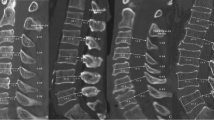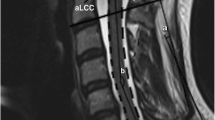Abstract
Purpose
Narrow cervical canal (NCC) has been a suspected risk factor for later development of cervical myelopathy. However, few studies have evaluated the prevalence in asymptomatic subjects. The purpose of this study was to investigate the prevalence of NCC in a large cohort of asymptomatic volunteers.
Methods
This study was a cross-sectional study of 1211 asymptomatic volunteers. Approximately 100 men and 100 women representing each decade of life from the 20s to the 70s were included in this study. Cervical canal anteroposterior diameters at C5 midvertebral level on X-rays, and the prevalence of spinal cord compression (SCC) and increased signal intensity (ISI) changes on MRI were evaluated. Receiver operating characteristic analysis was performed to determine the cut-off value of the severity of canal stenosis resulting in SCC.
Results
NCC (<14 mm) was observed in 123 (10.2 %) subjects. SCC and ISI were found in 64 (5.3 %) and 28 (2.3 %) subjects, respectively. The prevalence of NCC was significantly higher in females and older subjects, but the occurrence of severe NCC (<12 mm) did not increase with age. The canal size in subjects with SCC or ISI was significantly smaller than in those without SCC (p < 0.0001). The cut-off values of cervical canal stenosis resulting in SCC were 14.8 and 13.9 mm in males and females, respectively.
Conclusions
The prevalence of NCC was considerably lower among asymptomatic healthy volunteers; the cervical canal diameter in subjects with SCC or ISI was significantly smaller than in asymptomatic subjects; NCC is a risk factor for SCC.


Similar content being viewed by others
References
Kalsi-Ryan S, Karadimas SK, Fehlings MG (2013) Cervical spondylotic myelopathy the clinical phenomenon and the current pathobiology of an increasingly prevalent and devastating disorder. Neuroscientist 19:409–421
Nouri A, Tetreault L, Singh A, Karadimas SK, Fehlings MG (2015) Degenerative cervical myelopathy: epidemiology, genetics and pathogenesis. Spine (Phila Pa 1976). doi:10.1097/brs.0000000000000913
Baptiste DC, Fehlings MG (2006) Pathophysiology of cervical myelopathy. Spine J Off J N Am Spine Soc 6:190s–197s. doi:10.1016/j.spinee.2006.04.024
Karadimas SK, Erwin WM, Ely CG, Dettori JR, Fehlings MG (2013) The pathophysiology and natural history of cervical spondylotic myelopathy. Spine 38(22 Suppl 1):S21–S36
Kasai Y, Akeda K, Uchida A (2007) Physical characteristics of patients with developmental cervical spinal canal stenosis. Eur Spine J Off Publ Eur Spine Soc Eur Spinal Deform Soc Eur Sect Cerv Spine Res Soc 16:901–903. doi:10.1007/s00586-007-0358-2
Hayashi H, Okada K, Hamada M, Tada K, Ueno R (1987) Etiologic factors of myelopathy. A radiographic evaluation of the aging changes in the cervical spine. Clin Orthop Relat Res (214):200–209
Inoue H, Ohmori K, Takatsu T, Teramoto T, Ishida Y, Suzuki K (1996) Morphological analysis of the cervical spinal canal, dural tube and spinal cord in normal individuals using CT myelography. Neuroradiology 38:148–151
Sasaki T, Kadoya S, Iizuka H (1998) Roentgenological study of the sagittal diameter of the cervical spinal canal in normal adult Japanese. Neurol Med Chir (Tokyo) 38:83–88 discussion 88–89
Edwards WC, LaROCCA H (1983) The developmental segmental sagittal diameter of the cervical spinal canal in patients with cervical spondylosis. Spine 8:20–27
Torg JS, Naranja RJ Jr, Pavlov H, Galinat BJ, Warren R, Stine RA (1996) The relationship of developmental narrowing of the cervical spinal canal to reversible and irreversible injury of the cervical spinal cord in football players. J Bone Jt Surg Am 78:1308–1314
Gore DR (2001) Roentgenographic findings in the cervical spine in asymptomatic persons: a 10-year follow-up. Spine (Phila Pa 1976) 26:2463–2466
Morishita Y, Naito M, Hymanson H, Miyazaki M, Wu G, Wang JC (2009) The relationship between the cervical spinal canal diameter and the pathological changes in the cervical spine. Eur Spine J Off Publ Eur Spine Soc Eur Spinal Deform Soc Eur Sect Cerv Spine Res Soc 18:877–883. doi:10.1007/s00586-009-0968-y
Shigematsu H, Ueda Y, Koizumi M, Takeshima T, Tanaka Y, Satoh N, Matsumori H, Oshima T, Matsuyama E, Kugai A, Takakura Y (2008) Does developmental canal stenosis influence surgical results of bilateral open-door laminoplasty for cervical spondylotic myelopathy? J Neurosurg Spine 9:358–362. doi:10.3171/spi.2008.9.10.358
Higo M (1987) Roentgenological study of anterior–posterior diameter in developmental canal stenosis of cervical spine. Nihon Seikeigeka Gakkai Zasshi 61:455–465
Nagata K, Yoshimura N, Hashizume H, Muraki S, Ishimoto Y, Yamada H, Takiguchi N, Nakagawa Y, Minamide A, Oka H (2014) The prevalence of cervical myelopathy among subjects with narrow cervical spinal canal in a population-based magnetic resonance imaging study: the Wakayama Spine Study. Spine J 14:2811–2817
Yukawa Y, Kato F, Suda K, Yamagata M, Ueta T (2012) Age-related changes in osseous anatomy, alignment, and range of motion of the cervical spine. Part I: radiographic data from over 1200 asymptomatic subjects. Eur Spine J Off Publ Eur Spine Soc Eur Spinal Deform Soc Eur Sect Cerv Spine Res Soc 21:1492–1498. doi:10.1007/s00586-012-2167-5
Kato F, Yukawa Y, Suda K, Yamagata M, Ueta T (2012) Normal morphology, age-related changes and abnormal findings of the cervical spine. Part II: magnetic resonance imaging of over 1200 asymptomatic subjects. Eur Spine J Off Publ Eur Spine Soc Eur Spinal Deform Soc Eur Sect Cerv Spine Res Soc 21:1499–1507. doi:10.1007/s00586-012-2176-4
Nakashima H, Yukawa Y, Suda K, Yamagata M, Ueta T, Kato F (2015) Abnormal findings on magnetic resonance images of the cervical spines in 1211 asymptomatic subjects. Spine 40:392–398
Yukawa Y, Kato F, Yoshihara H, Yanase M, Ito K (2007) MR T2 image classification in cervical compression myelopathy: predictor of surgical outcomes. Spine 32:1675–1678
Murone I (1974) The importance of the sagittal diameters of the cervical spinal canal in relation to spondylosis and myelopathy. J Bone Jt Surg Br 56:30–36
Higo M, Sakou T, Suzuki Y, Matsumoto R, Ito H, Kosakura H (1984) Roentogenologicalstudyoftheantero-posteriordiameter in cervical developmental canal stenosis [in Japanese]. Rinsho Seikei Geka 19:361–366
Goto S-I, Umehara J, Aizawa T, Kokubun S (2010) Comparison of cervical spinal canal diameter between younger and elder generations of Japanese. J Orthop Sci 15:97–103
Wolf BS, Khilnani M, Malis L (1956) The sagittal diameter of the bony cervical spinal canal and its significance in cervical spondylosis. J Mt Sinai Hosp N Y 23:283–292
Acknowledgments
This study was supported by institutional funds and by grant research funds, which are intended for promoting hospital functions, of the Japan Labor Health and Welfare Organization (Kawasaki, Japan).
Author information
Authors and Affiliations
Corresponding author
Ethics declarations
Conflict of interest
None.
Disclosure of funding
No benefits in any form have been or will be received from a commercial party related directly or indirectly to the subject of this manuscript.
Rights and permissions
About this article
Cite this article
Nakashima, H., Yukawa, Y., Suda, K. et al. Narrow cervical canal in 1211 asymptomatic healthy subjects: the relationship with spinal cord compression on MRI. Eur Spine J 25, 2149–2154 (2016). https://doi.org/10.1007/s00586-016-4608-z
Received:
Revised:
Accepted:
Published:
Issue Date:
DOI: https://doi.org/10.1007/s00586-016-4608-z




